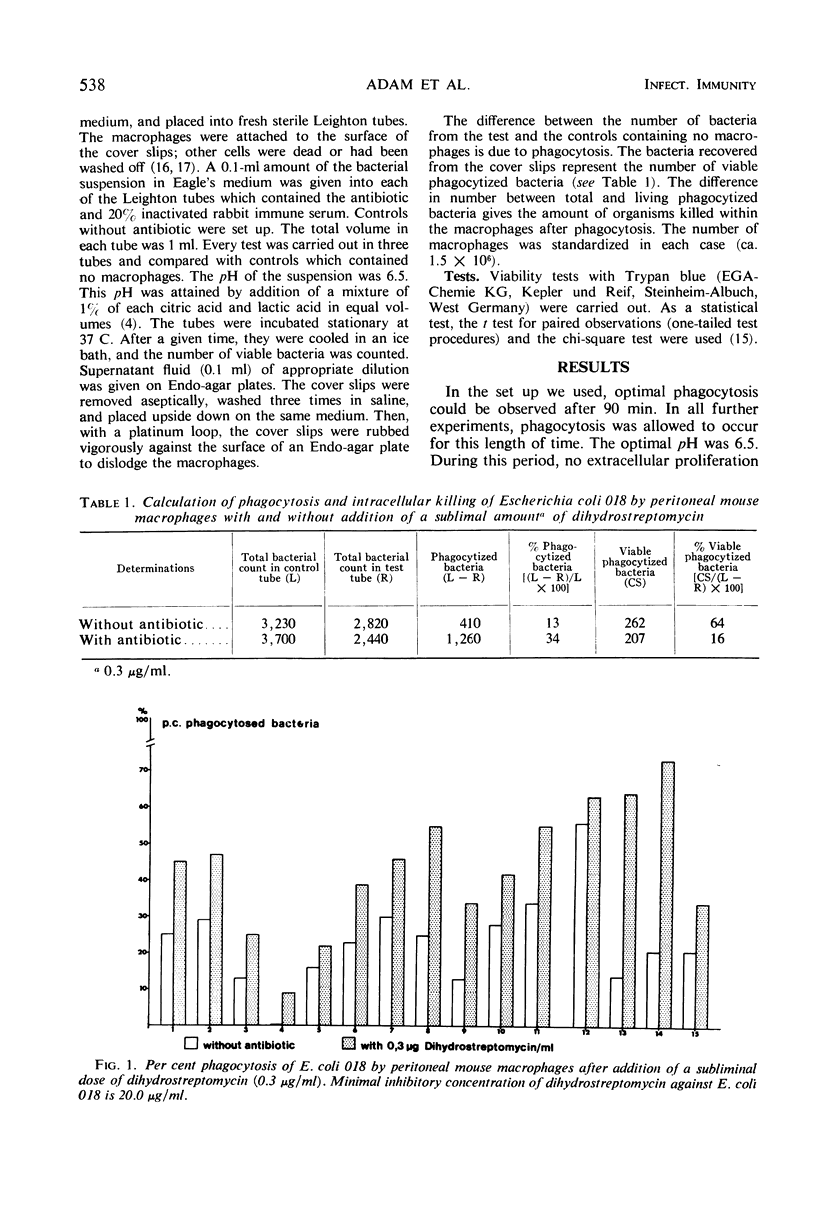Abstract
The effect of the antibiotic dihydrostreptomycin on the phagocytic and bactericidal ability of peritoneal macrophages obtained from mice has been investigated. In subliminal concentrations which did not influence the bacterial growth, the drug caused macrophages to ingest and kill bacteria (Escherichia coli) at a higher rate than did macrophages without antibiotic. The differences for phagocytosis and intracellular killing of E. coli with and without a subliminal amount of dihydrostreptomycin were statistically significant. Macrophages pretreated with the antibiotic did not demonstrate any enhancement of phagocytosis.
Full text
PDF




Selected References
These references are in PubMed. This may not be the complete list of references from this article.
- Adam D., Marget W. Die Rolle des Wirts bei der klinischen Wirkung der antibakteriellen Chemotherapie. Med Klin. 1971 Mar 5;66(10):344–351. [PubMed] [Google Scholar]
- Adam D., Philipp P., Belohradsky B. H. Studies on the influence of host defence mechanisms on the antimicrobial effect of chemotherapeutic agents. Effect of antibiotics on phagocytosis of mouse-peritoneal-macrophages in vitro. Arztl Forsch. 1971 Jun 10;25(6):181–184. [PubMed] [Google Scholar]
- Beck A., Bergner-Rabinowitz S., Ofek I. Effect of pH on in vitro phagocytosis of Streptococcus pyogenes. J Bacteriol. 1969 Dec;100(3):1204–1207. doi: 10.1128/jb.100.3.1204-1207.1969. [DOI] [PMC free article] [PubMed] [Google Scholar]
- Bishop D. C., Gottlieb A. A. Macrophages, RNAs and the immune response. Curr Top Microbiol Immunol. 1970;51:1–26. doi: 10.1007/978-3-642-46213-9_1. [DOI] [PubMed] [Google Scholar]
- Bonventre P. F., Hayes R., Imhoff J. Autoradiographic evidence for the impermeability of mouse peritoneal macrophages to tritiated streptomycin. J Bacteriol. 1967 Jan;93(1):445–450. doi: 10.1128/jb.93.1.445-450.1967. [DOI] [PMC free article] [PubMed] [Google Scholar]
- Degré M. Phagocytic and bactericidal activities of peritoneal and alveolar macrophages from mice. J Med Microbiol. 1969 Aug;2(3):353–357. doi: 10.1099/00222615-2-3-353. [DOI] [PubMed] [Google Scholar]
- Ehrenreich B. A., Cohn Z. A. The uptake and digestion of iodinated human serum albumin by macrophages in vitro. J Exp Med. 1967 Nov 1;126(5):941–958. doi: 10.1084/jem.126.5.941. [DOI] [PMC free article] [PubMed] [Google Scholar]
- FRIEDMAN A. An evaluation of chloramphenicol therapy in typhoid fever in children. Pediatrics. 1954 Jul;14(1):28–37. [PubMed] [Google Scholar]
- Gallily R., Feldman M. The role of macrophages in the induction of antibody in x-irradiated animals. Immunology. 1967 Feb;12(2):197–206. [PMC free article] [PubMed] [Google Scholar]
- Holmes B., Quie P. G., Windhorst D. B., Pollara B., Good R. A. Protection of phagocytized bacteria from the killing action of antibiotics. Nature. 1966 Jun 11;210(5041):1131–1132. doi: 10.1038/2101131a0. [DOI] [PubMed] [Google Scholar]
- Huber H., Fudenberg H. H. Die immunologische Funktion von Monocyten und Makrophagen. Klin Wochenschr. 1969 Oct 15;47(20):1061–1068. doi: 10.1007/BF01496637. [DOI] [PubMed] [Google Scholar]
- MACKANESS G. B. The phagocytosis and inactivation of staphylococci by macrophages of normal rabbits. J Exp Med. 1960 Jul 1;112:35–53. doi: 10.1084/jem.112.1.35. [DOI] [PMC free article] [PubMed] [Google Scholar]
- NETER E., BERTRAM L. F., ZAK D. A., MURDOCK M. R., ARBESMAN C. E. Studies on hemagglutination and hemolysis by escherichia coli antisera. J Exp Med. 1952 Jul;96(1):1–15. doi: 10.1084/jem.96.1.1. [DOI] [PMC free article] [PubMed] [Google Scholar]
- ROWLEY D. Bactericidal activity of macrophages in vitro against Escherichia coli. Nature. 1958 Jun 21;181(4625):1738–1739. doi: 10.1038/1811738b0. [DOI] [PubMed] [Google Scholar]
- ROWLEY D., WHITBY J. L. The bactericidal activity of mouse macrophages in vitro. Br J Exp Pathol. 1959 Oct;40:507–515. [PMC free article] [PubMed] [Google Scholar]
- SAHA A., GARVEY J. S., CAMPBELL D. H. THE PHYSICOCHEMICAL CHARACTERIZATION OF THE RIBONUCLEIC ACID-ANTIGEN COMPLEX PERSISTING IN THE LIVER OF IMMUNIZED RABBITS. Arch Biochem Biophys. 1964 Apr;105:179–192. doi: 10.1016/0003-9861(64)90251-6. [DOI] [PubMed] [Google Scholar]
- SEELEMANN K., NEUMANN H. Moderne Scharlachbehandlung und Antistreptolysinreaktion. Dtsch Med Wochenschr. 1954 Dec 3;79(49):1825–passim. doi: 10.1055/s-0028-1119980. [DOI] [PubMed] [Google Scholar]
- WHITBY J. L., ROWLEY D. The role of macrophages in the elimination of bacteria from the mouse peritoneum. Br J Exp Pathol. 1959 Aug;40:358–370. [PMC free article] [PubMed] [Google Scholar]
- WIESENER H., STUCK B. Antistreptolysintiter und Krankheitsimmunität bei Scharlach. Klin Wochenschr. 1955 Sep 15;33(35-36):845–848. doi: 10.1007/BF01467123. [DOI] [PubMed] [Google Scholar]
- van Furth R. Origin and kinetics of monocytes and macrophages. Semin Hematol. 1970 Apr;7(2):125–141. [PubMed] [Google Scholar]


